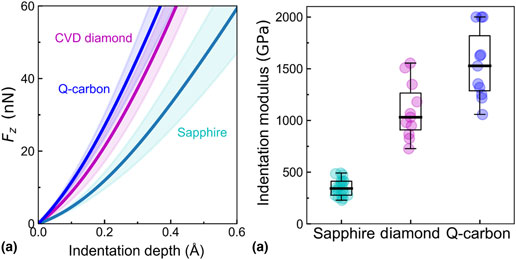Crossref Citations
This article has been cited by the following publications. This list is generated based on data provided by
Crossref.
Gupta, Siddharth
Sachan, Ritesh
Bhaumik, Anagh
Pant, Punam
and
Narayan, Jagdish
2018.
Undercooling driven growth of Q-carbon, diamond, and graphite.
MRS Communications,
Vol. 8,
Issue. 2,
p.
533.
Haque, Ariful
and
Narayan, Jagdish
2018.
Stability of electron field emission in Q-carbon.
MRS Communications,
Vol. 8,
Issue. 3,
p.
1343.
Gupta, Siddharth
Sachan, Ritesh
Bhaumik, Anagh
and
Narayan, Jagdish
2018.
Enhanced mechanical properties of Q-carbon nanocomposites by nanosecond pulsed laser annealing.
Nanotechnology,
Vol. 29,
Issue. 45,
p.
45LT02.
Narayan, Jagdish
Bhaumik, Anagh
Gupta, Siddharth
Haque, Ariful
and
Sachan, Ritesh
2018.
Progress in Q-carbon and related materials with extraordinary properties.
Materials Research Letters,
Vol. 6,
Issue. 7,
p.
353.
Gupta, Siddharth
and
Narayan, Jagdish
2019.
Non-equilibrium processing of ferromagnetic heavily reduced graphene oxide.
Carbon,
Vol. 153,
Issue. ,
p.
663.
Sachan, Ritesh
Bhaumik, Anagh
Pant, Punam
Prater, John
and
Narayan, Jagdish
2019.
Diamond film growth by HFCVD on Q-carbon seeded substrate.
Carbon,
Vol. 141,
Issue. ,
p.
182.
Bhaumik, Anagh
and
Narayan, Jagdish
2019.
Nano-to-micro diamond formation by nanosecond pulsed laser annealing.
Journal of Applied Physics,
Vol. 126,
Issue. 12,
Narayan, J.
Gupta, S.
Sachan, R.J.
Niebroski, A.
and
Pant, P.
2019.
Formation of Q-carbon and diamond coatings on WC and steel substrates.
Diamond and Related Materials,
Vol. 98,
Issue. ,
p.
107515.
Sachan, Ritesh
Hachtel, Jordan A.
Bhaumik, Anagh
Moatti, Adele
Prater, John
Idrobo, Juan Carlos
and
Narayan, Jagdish
2019.
Emergence of shallow energy levels in B-doped Q-carbon: A high-temperature superconductor.
Acta Materialia,
Vol. 174,
Issue. ,
p.
153.
Bhaumik, Anagh
and
Narayan, Jagdish
2019.
Formation and characterization of nano- and microstructures of twinned cubic boron nitride.
Physical Chemistry Chemical Physics,
Vol. 21,
Issue. 4,
p.
1700.
Gupta, Siddharth
and
Narayan, Jagdish
2019.
Reduced Graphene Oxide/Amorphous Carbon P–N Junctions: Nanosecond Laser Patterning.
ACS Applied Materials & Interfaces,
Vol. 11,
Issue. 27,
p.
24318.
Gupta, Siddharth
Sachan, Ritesh
and
Narayan, Jagdish
2019.
Scale-up of Q‑carbon and nanodiamonds by pulsed laser annealing.
Diamond and Related Materials,
Vol. 99,
Issue. ,
p.
107531.
Cellini, Filippo
Gao, Yang
and
Riedo, Elisa
2019.
Å-Indentation for non-destructive elastic moduli measurements of supported ultra-hard ultra-thin films and nanostructures.
Scientific Reports,
Vol. 9,
Issue. 1,
Joshi, Pratik
Gupta, Siddharth
Haque, Ariful
and
Narayan, Jagdish
2020.
Fabrication of ultrahard Q-carbon nanocoatings on AISI 304 and 316 stainless steels and subsequent formation of high-quality diamond films.
Diamond and Related Materials,
Vol. 104,
Issue. ,
p.
107742.
Zare, Yasser
and
Rhee, Kyong Yop
2020.
Modeling the Effects of Filler Network and Interfacial Shear Strength on the Mechanical Properties of Carbon Nanotube-Reinforced Nanocomposites.
JOM,
Vol. 72,
Issue. 6,
p.
2184.
Nishikawa, Naofumi
2020.
Evidence of hydrogen termination at grain boundaries in ultrananocrystalline diamond/hydrogenated amorphous carbon composite thin films synthesized via coaxial arc plasma.
Journal of Vacuum Science & Technology B, Nanotechnology and Microelectronics: Materials, Processing, Measurement, and Phenomena,
Vol. 38,
Issue. 6,
Haque, Ariful
Gupta, Siddharth
and
Narayan, Jagdish
2020.
Characteristics of Diamond Deposition on Al2O3, Diamond-like Carbon, and Q-Carbon.
ACS Applied Electronic Materials,
Vol. 2,
Issue. 5,
p.
1323.
Gupta, Siddharth
Sachan, Ritesh
and
Narayan, Jagdish
2020.
Nanometer-Thick Hexagonal Boron Nitride Films for 2D Field-Effect Transistors.
ACS Applied Nano Materials,
Vol. 3,
Issue. 8,
p.
7930.
Yoshinaka, Hiroki
Inubushi, Seiko
Wakita, Takanori
Yokoya, Takayoshi
and
Muraoka, Yuji
2020.
Formation of Q-carbon by adjusting sp3 content in diamond-like carbon films and laser energy density of pulsed laser annealing.
Carbon,
Vol. 167,
Issue. ,
p.
504.
Fujii, Yasumaru
Maruyama, Mina
Cuong, Nguyen Thanh
and
Okada, Susumu
2020.
Pentadiamond: A Hard Carbon Allotrope of a Pentagonal Network of
sp2
and
sp3
C Atoms.
Physical Review Letters,
Vol. 125,
Issue. 1,




